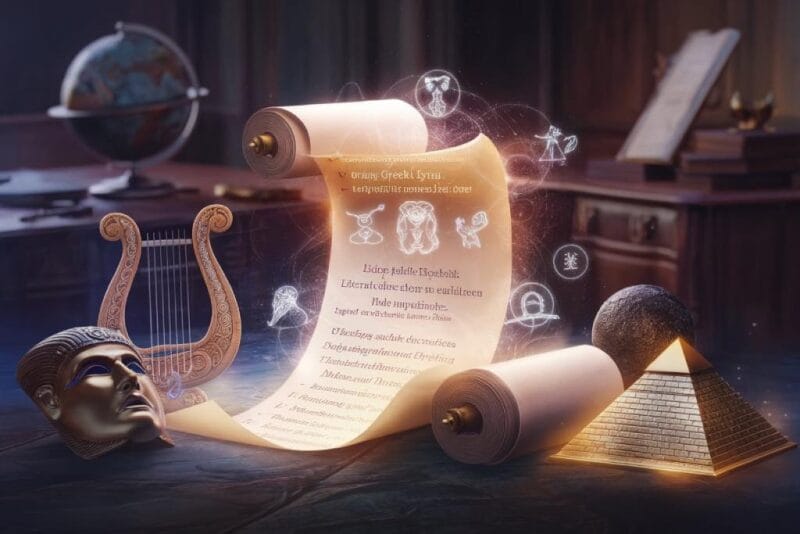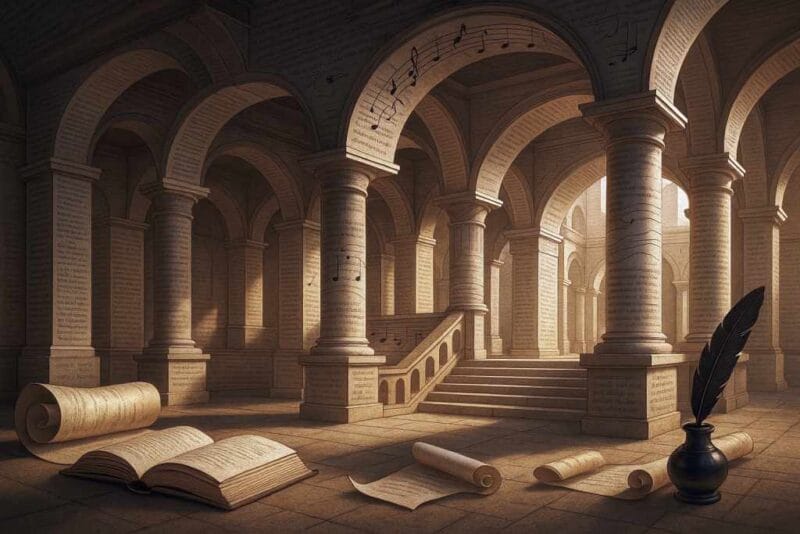Pastiche has served as a critical method for authors to engage with literary styles throughout history. It represents creative imitation: authors take up an existing voice or method and transform it to express something new. This reminds us that every act of creation carries traces of what preceded it. Imitation, when deliberate and thoughtful, can therefore become a means of genuine expression.
Pastiche Definition
The word “pastiche” derives from the Italian pasticcio—a kind of pie made from assorted ingredients—and from the French pastiche, both of which suggest mixture. In English usage, the term came to signify a work combining or imitating styles and motifs drawn from earlier works. In literature, it often appears when a writer adopts another’s tone, rhythm, or structure to explore how influence can become another form of artistry.
Key Characteristics
A few essential features of pastiche:
- Imitation of style, tone, voice, or structure from an earlier author or work.
- Homage rather than mockery: unlike parody, pastiche honors the source rather than ridicules it.
- Re-contextualization or blending: the borrowed elements may be combined, adjusted, or placed in new settings so as to create a fresh effect, while still signifying their origin.
- Intertextual awareness: the work often encourages the reader to recognize the original source or style being imitated, establishing a dialogue with earlier creations.
Pastiche vs. Related Concepts
It helps to compare pastiche with two adjacent terms:
- Parody: Emphasizes mockery or exaggeration of the original; its tone tends toward satire. Pastiche doesn’t aim to ridicule but to celebrate.
- Homage: A more subtle and respectful tribute; homage may simply reference another work, while pastiche often replicates its style or technique more fully and consistently.
How Pastiche Works in Practice
Forms and Strategies
Pastiche can operate in several different ways. One strategy is direct imitation: an author consciously writes in the voice of another writer or mimics a specific work’s structure. Another is hybridization: elements from multiple sources are blended into a new piece, creating a layered pastiche. For example, in literary pastiche, one might replicate a distinctive writer’s vocabulary, sentence rhythm, narrative conventions, or thematic preoccupations.
Functions and Effects
Writers and artists choose pastiche for various reasons. It can function as a tribute to a master writer or style, as a way to explore tradition, or as a learning tool. Educators even use pastiche in classrooms so that students practice writing “in the manner of” a poet or author. Beyond these purposes, pastiche encourages reflection on originality and influence, since it highlights how a creative work engages with those that came before it.
Considerations and Criticisms
Because pastiche borrows so openly, issues of authenticity or creativity sometimes arise. Critics may argue that pastiche is derivative rather than original. Yet many treat it as a valid technique—as long as it is clearly imitative and acknowledges its sources.
Key Examples from Literature and Popular Culture
Here are a handful of notable examples from literature (though the device appears in music, film, and visual art too).
- Rosencrantz and Guildenstern Are Dead (1966) by Tom Stoppard: This tragicomedy takes two minor characters from Hamlet (1603) and reimagines their perspective. The play closely mirrors the language and events of the original Shakespearean work but shifts the focus and tone. Critics often label it a pastiche because it honors the style of Hamlet while rewriting its frame through a new lens.
- The British Museum Is Falling Down (1965) by David Lodge: In this novel, the author explicitly mimics and evokes the styles of several well-known novelists, including Virginia Woolf, Franz Kafka, and Ernest Hemingway. The text abandons a single voice and becomes a pastiche of multiple influences layered together.
- Holmesian pastiches: The iconic character Sir Arthur Conan Doyle’s detective Sherlock Holmes has inspired countless new works that imitate his tone, voice, and setting—collectively called Holmes pastiches. For example, the novel The Seven‑Per‑Cent Solution (1974) by Nicholas Meyer is widely regarded as a classic Holmes pastiche. These works borrow the detective’s voice and world while continuing or reimagining adventures in the same style.
- Pastiche in music and popular culture: Although our focus is literary, it is worth noting that pastiche appears in music. For instance, 2010s pop songs that deliberately evoke earlier decades’ sounds have been described as part of an “Age of Pastiche Pop.”
Why Writers Use Pastiche
Writers may turn to pastiche for several practical reasons. A pastiche can function as a creative workshop: by adopting another author’s style, a writer learns technique and structure. In classroom settings, for example, students write poems in the style of established poets to deepen their craft.
Pastiche also serves as a form of tribute: by explicitly echoing a master’s voice, an author acknowledges influence while engaging creatively with it. Through this act, a writer situates their work within a broader conversation of style and influence, thereby deepening the reader’s experience of recognition and connection. Furthermore, pastiche helps readers and writers explore issues of originality: when the boundary between imitation and invention becomes visible, creative practice becomes more self-aware.
How to Recognize Pastiche
If you wish to identify pastiche in literature, consider these indicators:
- Does the work adopt the tonal or structural hallmarks of a prior writer or era (vocabulary, syntax, imagery, narrative devices)?
- Is the imitation marked by respect rather than mockery of the original?
- Can the story be recognized through familiar characters, settings, or plot elements that have been recast to present a new perspective?
- Does it combine multiple source styles into a hybrid form or place them in a fresh context?
When you ask these questions, you can spot pastiche and understand how the writer works within and alongside earlier forms.
Further Reading
Pastiche on Wikipedia
What Is Pastiche in Literature, and Why Is Sherlock Holmes Perfect for It? by Timothy Miller, Writer’s Digest
Pastiche: Fan Fiction or Literature? by Geri Schear, rycardus.wordpress.com
Pastiche/collage as a literary style (x-post from r/books) on Reddit




